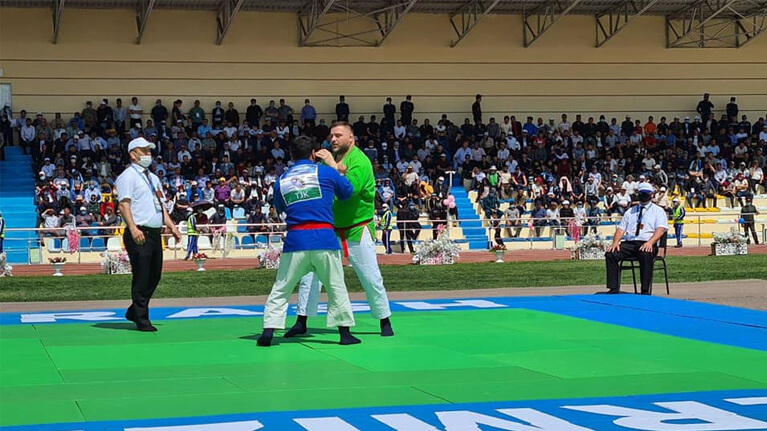Useful Links
- Official website of the President of Uzbekistan
- The Governmental portal of the Republic of Uzbekistan
- Senate of the Oliy Majlis of the Republic of Uzbekistan
- Legislative Chamber of the Oliy Majlis of the Republic of Uzbekistan
- Ministry of Foreign Affairs of the Republic of Uzbekistan
- Ministry of Investment, Industry and Trade of the Republic of Uzbekistan
- "Dunyo" Information Agency
Citizens of 76 countries will be able to get an electronic visa to Uzbekistan (List)
Uzbekistan announces visa waiver for citizens of 45 countries (List)
National Sports
The culture of each nation is unique, manifested in the language, traditions, customs, way of life, games. Preserving the continuity of spiritual values, norms, achievements is very significant, since this heritage is a necessary condition for the existence of a people as a nation. It is known that physical culture, having a long history, is an integral part of the general culture. And, for the public of Uzbekistan, the successes of both high-level sports and mass physical culture are important, where national sports that convey the social memory of the people are a bright component.
It should be noted that the way to modern sports lies through the national games. Let us list some traditional sports that have become an important component of the cultural memory of society and are being developed in modern Uzbekistan.

Alaman-baiga (poyga) is a folk race that reached its greatest development in the Middle Ages. It was held, as a rule, during the holidays, has not lost its significance, is included, as far as possible, in the program of holidays and sports and athletics. According to the rules: they saddled their horses, lined up in one line and, on a signal, rushed forward to a certain place, then the whole galloping cavalcade turned back; the one who returned first was considered the winner.
Baiga (poyga) - a long-distance jump. It was usually held during major complex competitions in the form of races over a distance of 50 km.
Chowgan - horse polo. The beginning of development dates back to the 7th-8th centuries, the game was one of the main entertainments of the warriors. The riders had special sticks (suljans) with which the ball was knocked out. The players were divided into two parties; each team tried to pass the ball into the opponent's goal. Sometimes the chougan was not played on horseback, reminiscent of modern field hockey.
In addition to equestrian sports, dorbozlik, the art of performing with a balance beam (langar) on a fixed rope, enjoyed success. The art of balancing act originated over 2.5 thousand years ago in the East, and then spread throughout the world. Rope walkers, who demonstrated excellent physical fitness and good coordination, performed during festivities and festivities.

Interest in kurash wrestling led to the development of other types of martial arts. For example, this is confirmed by the popularity, especially among young people, - “Uzbek zhang sanati” (Uzbek martial art) - a modern type of martial art that embodies the centuries-old traditions of the martial arts of the peoples of the region. This martial art was created on the basis of the studied heritage, enriched with effective techniques of various combat systems. This martial art is characterized by certain areas: sports, health-improving (for the age after 40 years), art of the hand (3,000 hand techniques), martial art of the Temurids (work with a knife, saber, stick, spear), combat wrestling. The complexes of defensive and attacking actions are named after historical figures, which undoubtedly contributes to patriotic education.
Another no less interesting type of martial arts, which cannot be ignored, is Turon (the historical meaning of the word is dexterous, strong, fearless) - martial arts containing elements of various styles that were encountered in ancient times in fights that took place on the territory of modern Uzbekistan. According to experts, in the past in the trading cities there were people involved in the escort and protection of caravans following the Great Silk Road. They possessed unique combat skills that allowed them to successfully confront numerous and well-armed opponents. These martial skills, which have been properly systematized and reworked, form the basis of Turon martial arts. At the same time, it should be taken into account that martial arts carries a specific philosophy, a system of worldview, acquaintance with which allows a fighter to achieve the required level of psychological preparation.
The listed national games, physical exercises, national sports that have been formed over the centuries, of course, comprehensively developed not only physical qualities (strength, speed, endurance, dexterity, flexibility), but also moral and volitional ones. Gradually, the utilitarian significance of the physical direction of personality development was not only supplemented by the promotion of a healthy lifestyle, active physical education and sports, but turned into a part of everyday life, into a form of leisure, and grew into the concept of its further organic development.





















